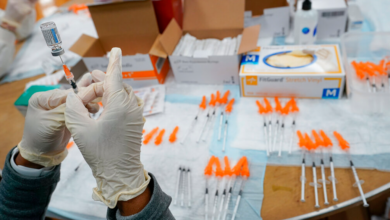Method of COVID-19 vaccine delivery in cells may be linked to cause of rare clot reaction, researchers say

A team of German researchers has suggested a mechanism behind rare but serious clotting events reported in recipients of COVID-19 vaccines developed by AstraZeneca and Johnson & Johnson.
As millions of jabs were rolled out, reports of exceedingly rare but potentially fatal clotting disorders sent over a dozen mostly European countries reeling, temporarily halting vaccination campaigns with AstraZeneca’s product in March. In the U.S., rare reports of serious blood clots following Johnson & Johnson’s single-dose jab resulted in an 11-day national recommended pause on J&J’s vaccine rollout, before a federal advisory committee suggested the U.S. resume rollout but include new language on the product’s emergency use authorization (EUA) warning remote risks of serious blood clots. AstraZeneca’s COVID-19 vaccine is not yet approved for use in the U.S.
In a statement sent to Fox News, a spokesperson at Janssen said “We are supporting continued research and analysis of this rare event as we work with medical experts and global health authorities. We look forward to reviewing and sharing data as it becomes available.”
SINOPHARM COVID-19 VACCINES APPEAR SAFE, EFFECTIVE, STUDY FINDS
AstraZeneca did not immediately respond to a request for comment.
The early findings posted ahead of peer review on Wednesday from researchers at the Goethe-University of Frankfurt suggested that while mRNA COVID-19 vaccines (Pfizer, Moderna) delivered on a fat-enclosed particle deposit instructions coding for the production of the spike protein in a fluid portion of cells called the cytosol, adenoviral vector COVID-19 vaccines (AstraZeneca, J&J) deliver instructions coding for the SARS-CoV-2 surface spike protein inside of the nucleus.
“And exactly here lies the problem: the viral piece of DNA – deriving from an RNA virus – is not optimized to be transcribed inside of the nucleus,” study authors wrote. “Thus, it could well be that the Spike open reading frame of SARS-CoV-2 is potentially disrupted by arbitrary splice events when transcribed inside the nucleus.”
The so-called splice events then create soluble spike proteins, “described to cause adverse effects, [such as] a strong inflammatory response.”
“Soluble Spike variants together with newly built antibodies against Spike protein as well as the highly specific blood flow conditions in the central venous sinus of the brain may result in the rare but severe events after vaccination observed with ADZ1222/Vaxzevria. Noteworthy, the vaccine from Johnson & Johnson appears to carry fewer splice donor sequences…This may explain the ~ 10-fold lower incidence of severe side effects with the Johnson & Johnson vaccine when compared to the AZD1222 vaccine,” the study reads.
Dr. Tom Shimabukuro with the CDC COVID-19 vaccine task force previously noted 28 total cases of so-called thrombosis with thrombocytopenia (TTS) following J&J vaccination were reported through a national surveillance system, Vaccine Adverse Event Reporting System (VAERS). TTS is a broad term including the rare but potentially deadly cerebral venous sinus thrombosis (CVST), but also deep vein thrombosis and pulmonary thromboembolism.
Shimabukuro presented data indicating females aged 30 to 39 had the highest reporting rates of TTS at 12.4 cases per million doses administered, though females aged 40 to 49 had the “most pronounced” increase in cases; the reporting rate in this age group is 9.4 clot cases per million doses administered.
In the study at hand, researchers offered hypotheses behind the clotting events predominantly affecting young women. They noted that older adults more often take drugs that tamp down clotting and inflammatory events.
“This could be a reason why elderly people suffer much less from these thromboembolic events.”
Also, younger people tend to have stronger immune systems, and women tend to have stronger immune responses than men, “All this would imply a higher incidence in young women when compared to men or elderly people,” study authors wrote.
“All mRNA-based vaccines should represent safe products,” they concluded, but strongly suggested “spike open reading frames in vector-based vaccines has to be re-optimized to avoid unintended splice reactions and to increase the safety of these pharmaceutical products.”
Other scientists have suggested different mechanisms behind the clotting, such as an autoimmune response involving “stray proteins” and a preservative in AstraZeneca’s vaccine called ethylenediaminetetraacetic acid, or EDTA, the Wall Street Journal reported.
Source link





